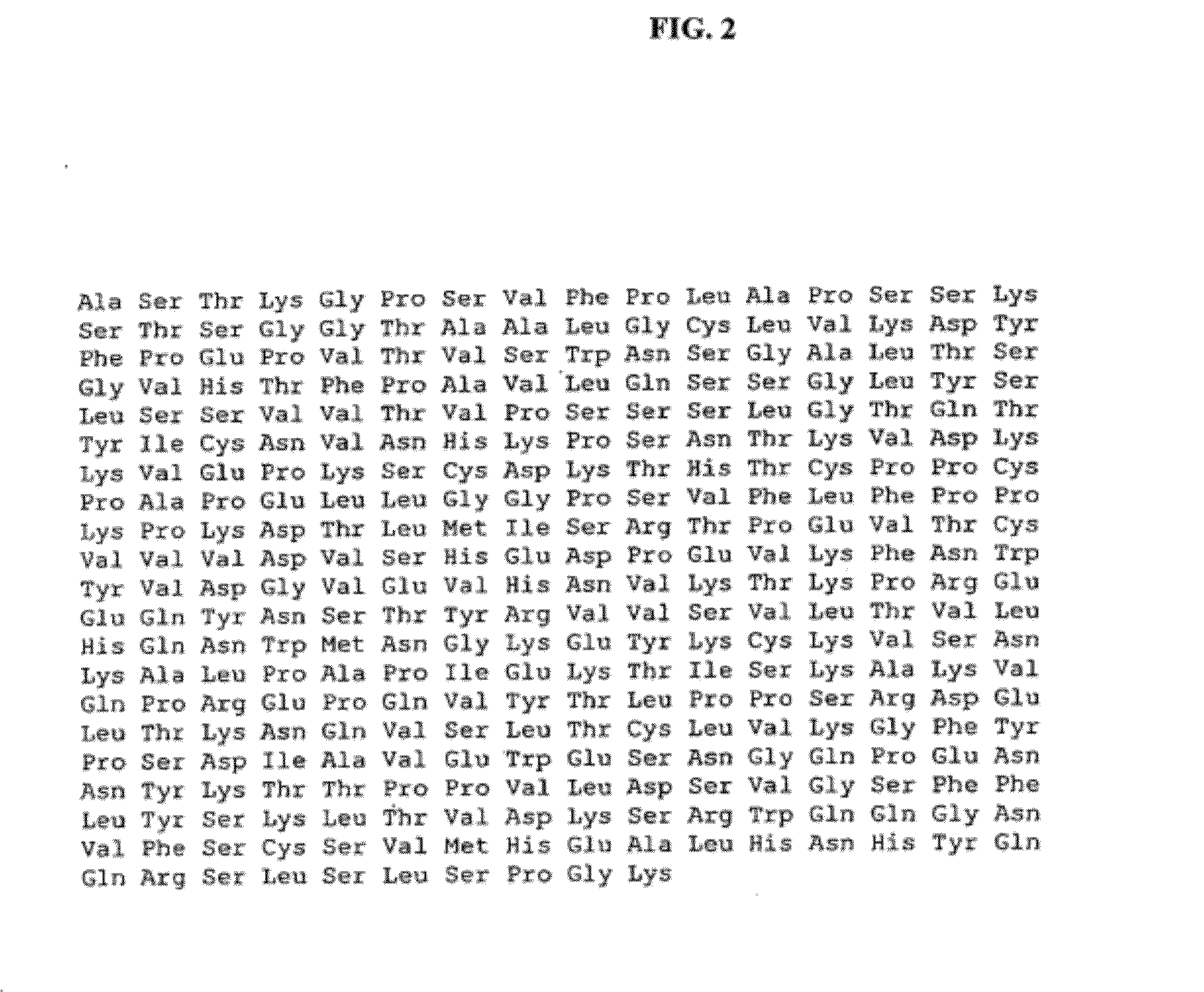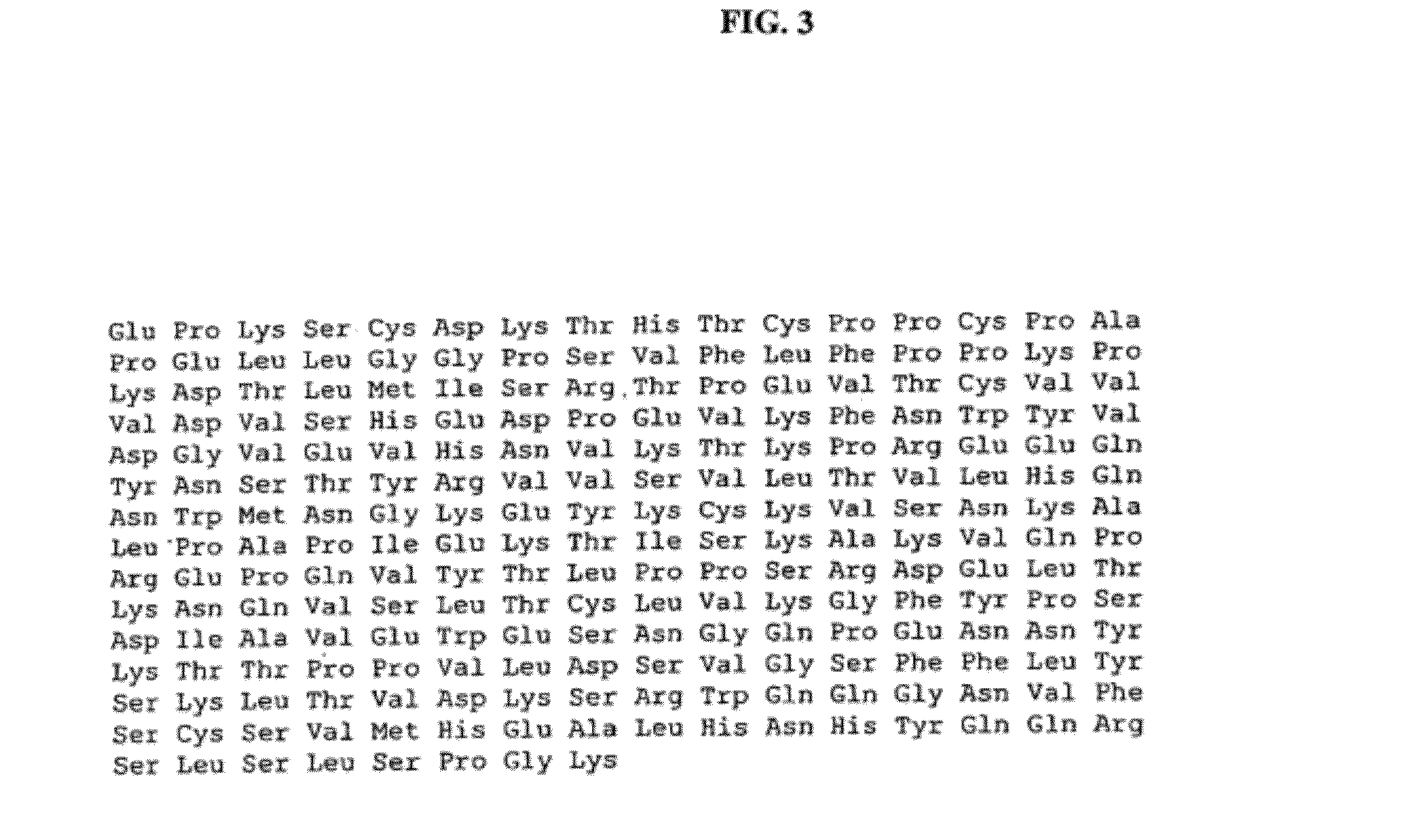Fusion molecules and methods for treatment of immune diseases
a fusion polypeptide and immune disease technology, applied in the direction of fused cells, immunological disorders, drug compositions, etc., can solve the problems of airway constriction and anaphylactic shock, and many of the current allergy treatment treatments have serious side effects. , to achieve the effect of preventing symptoms
- Summary
- Abstract
- Description
- Claims
- Application Information
AI Technical Summary
Benefits of technology
Problems solved by technology
Method used
Image
Examples
example 1
Construction and Expression of a Chimeric Human Fcγ-Fcε Fusion Protein Materials and Methods
[0233]Plasmids, vectors and cells—Plasmid pAG 4447 containing genomic DNA encoding human IgE constant region and expression vector pAN 1872 containing human genomic DNA encoding the hinge-CH2-CH3 portion of IgG, constant region were obtained from the laboratory of Dr. Morrison. pAN 1872 is derived from the pDisplay vector (Invitrogen). pAG 4447 was developed and used as a cloning intermediate in the construction of a human IgE expression vector disclosed in J. Biol. Chem. 271:3428-3436 (1996). To construct the chimeric gene, a pair of primers were designed to amplify the human IgE constant region (CH2-CH3-CH4).
5′-end primer:(SEQ ID NO: 8)5′GCTCGAGGGTGGAGGCGGTTCAGGCGGAGGTGGCTCTGGCGGTGGCGGATCGTTCACCCCGCCCACCGTGAAG3′,
containing a flexible linker sequence and an XhoI site.
3′ end primer:(SEQ ID NO: 9)5′GGCGGCCGCTCATTTACCGGGATTTACAGACAC3′,
containing a NotI site.
[0234]After amplification, the PCR pr...
example 2
Construction and Expression of Chimeric Human Fcγ-Autoantigen Fusion Proteins for Use in Treating Subjects with Multiple Sclerosis
[0245]Two human Fcγ-autoantigen fusion polypeptides are produced using recombinant DNA techniques and a mammalian protein overexpression system. The resulting recombinant fusion proteins are purified using immunoprecipitation techniques and analyzed, as described below. Two forms of the fusion polypeptide are described. Both forms of the fusion polypeptide contain the hinge-CH2-CH3 portion of the IgG1 constant region, as provided in SEQ ID NO:1. One form of the fusion polypeptide comprises a full length myelin-basic-protein (MBP) amino acid sequence (as provided in SEQ ID NO:12), while an alternative version of the fusion polypeptide comprises a portion of MBP containing essentially the minimal, immunodominant autoimmune epitope, i.e., MBP83-99. (Warren et al., Proc. Natl. Acad. Sci. USA 92:11061-11065 [1995] and Wucherpfennig et al., J. Clin. Invest., 10...
PUM
| Property | Measurement | Unit |
|---|---|---|
| binding constant | aaaaa | aaaaa |
| Tm | aaaaa | aaaaa |
| thermal melting point | aaaaa | aaaaa |
Abstract
Description
Claims
Application Information
 Login to View More
Login to View More - R&D Engineer
- R&D Manager
- IP Professional
- Industry Leading Data Capabilities
- Powerful AI technology
- Patent DNA Extraction
Browse by: Latest US Patents, China's latest patents, Technical Efficacy Thesaurus, Application Domain, Technology Topic, Popular Technical Reports.
© 2024 PatSnap. All rights reserved.Legal|Privacy policy|Modern Slavery Act Transparency Statement|Sitemap|About US| Contact US: help@patsnap.com










